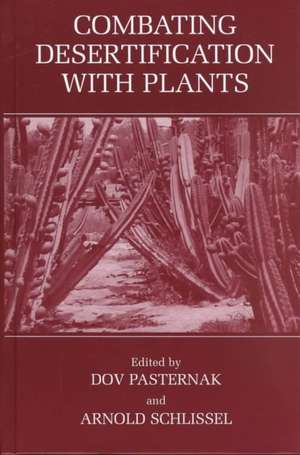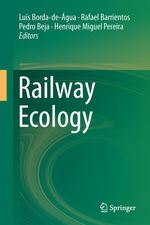Combating Desertification with Plants
Editat de D. Pasternak, Arnold Schlisselen Limba Engleză Hardback – 30 sep 2001
| Toate formatele și edițiile | Preț | Express |
|---|---|---|
| Paperback (1) | 958.88 lei 6-8 săpt. | |
| Springer Us – 13 oct 2012 | 958.88 lei 6-8 săpt. | |
| Hardback (1) | 963.60 lei 6-8 săpt. | |
| Springer Us – 30 sep 2001 | 963.60 lei 6-8 săpt. |
Preț: 963.60 lei
Preț vechi: 1175.12 lei
-18% Nou
Puncte Express: 1445
Preț estimativ în valută:
184.39€ • 197.17$ • 153.74£
184.39€ • 197.17$ • 153.74£
Carte tipărită la comandă
Livrare economică 17 aprilie-01 mai
Preluare comenzi: 021 569.72.76
Specificații
ISBN-13: 9780306466328
ISBN-10: 0306466325
Pagini: 462
Ilustrații: XVII, 462 p.
Dimensiuni: 178 x 254 x 27 mm
Greutate: 0.97 kg
Ediția:2001
Editura: Springer Us
Colecția Springer
Locul publicării:New York, NY, United States
ISBN-10: 0306466325
Pagini: 462
Ilustrații: XVII, 462 p.
Dimensiuni: 178 x 254 x 27 mm
Greutate: 0.97 kg
Ediția:2001
Editura: Springer Us
Colecția Springer
Locul publicării:New York, NY, United States
Public țintă
ResearchCuprins
1. Some Observations Relating to the Global Agricultural Situation.- 2. Combating Poverty with Plants.- I: Potential Germplasm for Arid Lands.- 3. The Role of Horticulture Plants in Combating Desertification.- 4. Terfezias, a Family of Mycorrhizal Edible Mushrooms for Arid Zones.- 5. The Role and Potential of Traditional Tuber Crops in Malawi.- 6. Honeybees and Nectariferous Plants in the Desert are an Important Factor to Sustain Modern Agriculture.- 7. Importance of Non-Wood Forest Products as Source of Rural Women’s Income in Western Burkina Faso.- 8. Ethnobotany and Importance of Three Local Species in Northern Cameroon.- 9. Potentials of Non-Wood Forest Products of the Semiarid Regions of Uganda.- 10. Biodiversity Prospecting in Drylands of Latin America.- 11. Provenance Trial for Indigenous Tree Species.- II: Introduction, Domestication and Dissemination of Arid Land Plants.- 12. Introduction and Selection of Drought and Salt Tolerant Plants for Afforestation and Landscaping in Arid Lands.- 13. The Screening of Multipurpose Tree Species for Agroforestry Practices in the Semiarid Ecozone of Ghana.- 14. Results of 50-Year Studies on Afforestation as Related to the Problem of Desertification Control in Ciscaspian Lowland in Russia.- 15. Citrullus colocynthis, an Israeli Desert Plant, as a Potential Source of Edible Oil.- 16. Euphorbia tirucalli for High Biomass Production.- 17. Boraginaceae as Potential Sources of Gamma-Linolenic Acid.- 18. Root Involvement in Plant Development and Productivity under Semiarid Conditions.- 19. Acacia mearnsii for Income Generation and Environmental Protection in Kenya.- 20. Potential of Australian Acacias for Human Food.- 21. The Effect of Shade on Initial Growth, Development and Occurrences of Leaf Diseases on Wild Indigenous FruitTrees.- 22. Afforestation of Semiarid Areas of Tanzania: Focusing on the Root Compartment.- 23. Introduction of Cacti as Vegetable Crops for Israel.- 24. Upscaling the Experimental Planting of Argania spinosa at Kibbutz Ketura, Israel.- 25. Mungbean (Vigna radiata L.), a Choice Crop for Improvement of Human and Soil Health in Southern Africa.- 26. Many Problems and Some Solutions to the Commercialisation of NTFPs in Botswana.- 27. Fighting Desertification by Production and Use of Jatropha Oil.- III: Land Rehabilitation.- 28. Combating Desertification with Seabuckthorn.- 29. Reversing Desertification with Tamarix in China.- 30. Bioreclamation of Saline Soils of the Western Coast of Senegal.- 31. Utilizing the Underground Forest: Farmer Managed Natural Regeneration of Trees.- 32. Sand Dune Stabilization with Plants in China.- 33. Development of a Technology for Sand Dune Stabilization in Northern Nigeria.- 34. Sand Dune Stabilization Practices Implemented in Turkey.- 35. Desertification in the West Bank and Gaza Strip.- 36. Reversing Desertification through Large, Herding Ungulates.- IV: Mechanisms of Plant Transfer.- 37. Passive Transfer.- 38. Response to Agroforestry Intervention.- 39. FAO, Plants and Sustainable Development in Drylands.- 40. Combating Desertification with Trees.- 41. Promoting Indigenous Tree Species Plantation in the Sahel, with Special Reference to Burkina Faso.- 42. Incorporating Tree and Shrub Species into Small Scale Farming Systems in the Dry Region of Indonesia.- 43. Obstacles to the Adoption of Cover Crops.












